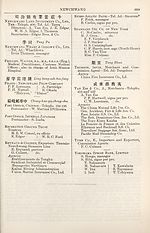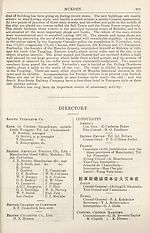1918
(744) [Page 670] - Manchurian Trade Centres -- Mukden
Download files
Complete book:
Individual page:
Thumbnail gallery: Grid view | List view
![(744) [Page 670] - Manchurian Trade Centres -- Mukden](https://deriv.nls.uk/dcn17/1949/0300/194903004.17.jpg)
MANCHURIAN TRADE CENTRES
In addition to Mukden, the Treaties made with China in 1903 by the United States
-and Japan secured the opening of Antung and Tatungkow in Manchuria. By an
additional agreement made between China and Japan in December, 1,905, the following
inland places in Manchuria were opened to trade on the dates specified :—September
10, 1906, Tieh-ling, Tung-chiang-tzu and Fakumen ; on October 8, Hsin-min Fu ; on
December 17, Manchuli, Harbin, Ch’ang-ch’un (K’uan-ch’eng-tzu) and Kirin; on
December 19, Tsitsihar (Pu-k’uei), the capital of the northern province of Hei-lung-
chiang ; and on June 28, 1907, the remaining seven places—Feng-liuang-ch’eng (Ring)
Liaq-yang, Ninguta., Hun-ch’un, Sansing, Hailar and Aihun—were declared open as a
preliminary step prior to the adoption of special settlement regulations. Only fit Harbin
and Antung are Foreign Consulates established.
MUKDEN
f# Shen-yang, formerly % ^ Feng-t'ien
(Mukden is the Manchu name.)
Mukden, formerly the capital of Manchuria, is now the capital of the province of
Feng-t‘ien 5^ It was the ancient seat of the late dynasty of China. Though
nominally opened to international residence and trade by the Commercial Treaties
concluded by the United States and Japan with China in 1903, it was not really
opened until 1906, for in the Russo-Japanese war the city became one of the
strongholds of the Russian forces, from which, however, they were eventually driven
by the advancing Japanese army after one of the most decisive battles of modern
times. When peace was concluded and the troops were withdrawn the trade possi¬
bilities of the province began to receive increased attention. The principal trade of
Mukden has been in grain, such as beans and millet ; it has also been a curing
centre for furs and has a considerable trade in bristles. Considerable indirect
business has been done with the city in European textiles and hardware, sugar and
kerosene oil.
Mukden is situated in slightly undulating country a few miles north of the Hunho,
a UWutary °F the river Liao, about 110 miles north-east of the port ofiNewchwang
■and has stations on the Chinese Government Railway and the South Manchuria
Kauiway H miles to the west of the city. The city stands four square, each side
being 2-334 h long, but it is not absolutely north and south. It is doubly walled. The
outer wall, which is circular and built of mud, encloses the suburbs and is 13
miles in circumference; the inner town, which is a mile square, is protected
oy a stone wall thirty-five feet high and fifteen wide on the top, pierced by eight
gates, two on each side, with high towers above them. A smaller wall encloses
tnc ancient palace, which stands in the centre of the inner city, like the palace
at reking. there are four main streets, which cross east and west, north and
soutn, Irom gate to gate. Mukden has four railway stations. Adjoining the station of
^ if- u°Uth ,anc"uria Railway is the large Japanese Concession, or Railway Area,
which was taken over from the Russians after the war. The total area of this Settle-
ment is about 1,500 acres. Between the mud wall and the Japanese Concession is the
Settlement set aside for the foreign residential and business quarter. Most of the big
yamen and Government buildings were erected in 1908, and throughout the city a great
In addition to Mukden, the Treaties made with China in 1903 by the United States
-and Japan secured the opening of Antung and Tatungkow in Manchuria. By an
additional agreement made between China and Japan in December, 1,905, the following
inland places in Manchuria were opened to trade on the dates specified :—September
10, 1906, Tieh-ling, Tung-chiang-tzu and Fakumen ; on October 8, Hsin-min Fu ; on
December 17, Manchuli, Harbin, Ch’ang-ch’un (K’uan-ch’eng-tzu) and Kirin; on
December 19, Tsitsihar (Pu-k’uei), the capital of the northern province of Hei-lung-
chiang ; and on June 28, 1907, the remaining seven places—Feng-liuang-ch’eng (Ring)
Liaq-yang, Ninguta., Hun-ch’un, Sansing, Hailar and Aihun—were declared open as a
preliminary step prior to the adoption of special settlement regulations. Only fit Harbin
and Antung are Foreign Consulates established.
MUKDEN
f# Shen-yang, formerly % ^ Feng-t'ien
(Mukden is the Manchu name.)
Mukden, formerly the capital of Manchuria, is now the capital of the province of
Feng-t‘ien 5^ It was the ancient seat of the late dynasty of China. Though
nominally opened to international residence and trade by the Commercial Treaties
concluded by the United States and Japan with China in 1903, it was not really
opened until 1906, for in the Russo-Japanese war the city became one of the
strongholds of the Russian forces, from which, however, they were eventually driven
by the advancing Japanese army after one of the most decisive battles of modern
times. When peace was concluded and the troops were withdrawn the trade possi¬
bilities of the province began to receive increased attention. The principal trade of
Mukden has been in grain, such as beans and millet ; it has also been a curing
centre for furs and has a considerable trade in bristles. Considerable indirect
business has been done with the city in European textiles and hardware, sugar and
kerosene oil.
Mukden is situated in slightly undulating country a few miles north of the Hunho,
a UWutary °F the river Liao, about 110 miles north-east of the port ofiNewchwang
■and has stations on the Chinese Government Railway and the South Manchuria
Kauiway H miles to the west of the city. The city stands four square, each side
being 2-334 h long, but it is not absolutely north and south. It is doubly walled. The
outer wall, which is circular and built of mud, encloses the suburbs and is 13
miles in circumference; the inner town, which is a mile square, is protected
oy a stone wall thirty-five feet high and fifteen wide on the top, pierced by eight
gates, two on each side, with high towers above them. A smaller wall encloses
tnc ancient palace, which stands in the centre of the inner city, like the palace
at reking. there are four main streets, which cross east and west, north and
soutn, Irom gate to gate. Mukden has four railway stations. Adjoining the station of
^ if- u°Uth ,anc"uria Railway is the large Japanese Concession, or Railway Area,
which was taken over from the Russians after the war. The total area of this Settle-
ment is about 1,500 acres. Between the mud wall and the Japanese Concession is the
Settlement set aside for the foreign residential and business quarter. Most of the big
yamen and Government buildings were erected in 1908, and throughout the city a great
Set display mode to:
![]() Universal Viewer |
Universal Viewer | ![]() Mirador |
Large image | Transcription
Mirador |
Large image | Transcription
Images and transcriptions on this page, including medium image downloads, may be used under the Creative Commons Attribution 4.0 International Licence unless otherwise stated. ![]()
| Asian directories and chronicles > 1918 > (744) [Page 670] - Manchurian Trade Centres -- Mukden |
|---|
| Permanent URL | https://digital.nls.uk/194903002 |
|---|
| Attribution and copyright: |
|
|---|---|
| Description | Volumes from the Asian 'Directory and Chronicle' series covering 1917-1941, but missing 1919 and 1923. Compiled annually from a multiplicity of local sources and research. They provide listings of each country's active corporations, foreign residents and government agencies of all nationalities for that year, together with their addresses. Content includes: various treaties; coverage of conflicts; currencies and taxes; consular fees; weights and measures; public holidays; festivals and traditions. A source of information for both Western states and communities of foreigners living in Asia. Published by Hongkong Daily Press. |
|---|---|
| Shelfmark | H3.86.1303 |
| Additional NLS resources: |

